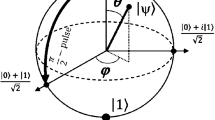Abstract
The path integral is not typically utilized for analyzing entanglement experiments, in part because there is no standard toolbox for converting an arbitrary experiment into a form allowing a simple sum-over-history calculation. After completing the last portion of this toolbox (a technique for implementing multi-particle measurements in an entangled basis), some interesting 4- and 6-particle experiments are analyzed with this alternate technique. While the joint probabilities of measurement outcomes are always equivalent to conventional quantum mechanics, differences in the calculations motivate a number of foundational insights, concerning nonlocality, retrocausality, and the objectivity of entanglement itself.






Similar content being viewed by others
Notes
This rule, and the other rules below, can be motivated by Eq. (1); squaring this amplitude gives the stated 50% probability for each possibility.
A third option, superdeterminism, posits a common cause of both \(\lambda\) and the settings.
Just as we would naturally say that such normal modes were caused by all of the adjustable mirror positions, the solution of an all-at-once calculation is caused by all of the controllable boundaries on the problem, both past and future.
References
Tyagi, N., Wharton, K.: Spacetime path integrals for entangled states. Found. Phys. 52(1), 1–23 (2022)
Pan, J.-W., Bouwmeester, D., Weinfurter, H., Zeilinger, A.: Experimental entanglement swapping: entangling photons that never interacted. Phys. Rev. Lett. 80(18), 3891 (1998)
Peres, A.: Delayed choice for entanglement swapping. J. Mod. Opt. 47(2–3), 139–143 (2000)
Ma, X.-S., Zotter, S., Kofler, J., Ursin, R., Jennewein, T., Brukner, Č, Zeilinger, A.: Experimental delayed-choice entanglement swapping. Nat. Phys. 8(6), 479–484 (2012)
Renou, M.-O., Bäumer, E., Boreiri, S., Brunner, N., Gisin, N., Beigi, S.: Genuine quantum nonlocality in the triangle network. Phys. Rev. Lett. 123(14), 140401 (2019)
Feynman, R.P.: QED: The Strange Theory of Light and Matter, vol. 33. Princeton University Press, Princeton (2006)
Sinha, S., Sorkin, R.D.: A sum-over-histories account of an epr (b) experiment. Found. Phys. Lett. 4(4), 303–335 (1991)
Hensen, B., Bernien, H., Dréau, A.E., Reiserer, A., Kalb, N., Blok, M.S., Ruitenberg, J., Vermeulen, R.F., Schouten, R.N., Abellán, C., et al.: Loophole-free bell inequality violation using electron spins separated by 1.3 kilometres. Nature 526(7575), 682–686 (2015)
Ning, W., Huang, X.-J., Han, P.-R., Li, H., Deng, H., Yang, Z.-B., Zhong, Z.-R., Xia, Y., Xu, K., Zheng, D., et al.: Deterministic entanglement swapping in a superconducting circuit. Phys. Rev. Lett. 123(6), 060502 (2019)
Egg, M.: Delayed-choice experiments and the metaphysics of entanglement. Found. Phys. 43(9), 1124–1135 (2013)
Price, H., Wharton, K.: Entanglement swapping and action at a distance. Found. Phys. 51(6), 1–24 (2021)
Wharton, K., Argaman, N.: Colloquium: Bell’s theorem and locally mediated reformulations of quantum mechanics. Rev. Mod. Phys. 92(2), 021002 (2020)
Wharton, K., Adlam, E.: Anti-correlated photons from classical electromagnetism. Phys. Rev. A 2022, 14 (2022)
Adlam, E.: Contextuality, fine-tuning and teleological explanation. Found. Phys. 51(6), 1–40 (2021)
Kraft, T., Designolle, S., Ritz, C., Brunner, N., Gühne, O., Huber, M.: Quantum entanglement in the triangle network. Phys. Rev. A 103(6), 060401 (2021)
Tavakoli, A., Pozas-Kerstjens, A., Renou, M.-O., et al.: Bell nonlocality in networks. Rep. Prog. Phys. 85, 056001 (2021)
Pozas-Kerstjens, A., Gisin, N., Renou, M.-O.: Proofs of network quantum nonlocality aided by machine learning. arXiv preprint arXiv:2203.16543 (2022)
Wharton, K.: Quantum states as ordinary information. Information 5(1), 190–208 (2014)
Adlam, E.: Laws of nature as constraints. Found. Phys. 52(1), 1–41 (2022)
Chen, E.K., Goldstein, S.: Governing without a fundamental direction of time: minimal primitivism about laws of nature. In: Ben-Menahem, Y. (ed.) Rethinking Laws of Nature. Springer, Berlin (2022)
Wharton, K.B., Miller, D.J., Price, H.: Action duality: a constructive principle for quantum foundations. Symmetry 3(3), 524–540 (2011)
Schulman, L.S.: Time’s Arrows and Quantum Measurement. Cambridge University Press, Cambridge (1997)
Wharton, K.: Time-symmetric boundary conditions and quantum foundations. Symmetry 2(1), 272–283 (2010)
Wharton, K.: Towards a realistic parsing of the Feynman path integral. Quanta 5(1), 1–11 (2016)
Adlam, E.: Two roads to retrocausality. arXiv preprint arXiv:2201.12934 (2022)
Almada, D., Ch’ng, K., Kintner, S., Morrison, B., Wharton, K.: Are retrocausal accounts of entanglement unnaturally fine-tuned? Int. J. Quantum Found. 2, 1–14 (2016)
Wharton, K.: A new class of retrocausal models. Entropy 20(6), 410 (2018)
Sutherland, R.: Probabilities and certainties within a causally symmetric model. arXiv preprint arXiv:2112.10022 (2021)
Acknowledgements
The authors would like to thank N.Argaman for bringing the intriguing features of the triangle network to our attention (and other useful advice), H. Price for encouraging us to think more carefully about entanglement swapping, E. Adlam for very useful insights, and of course N. Tyagi for her work on which this paper was based.
Author information
Authors and Affiliations
Contributions
KW wrote the main manuscript text and RL designed the general entangled measurement, performed calculations, and prepared the figures and equations. All authors reviewed the manuscript.
Corresponding author
Ethics declarations
Competing Interests
The authors have no competing interests to declare that are relevant to the content of this article.
Additional information
Publisher's Note
Springer Nature remains neutral with regard to jurisdictional claims in published maps and institutional affiliations.
Rights and permissions
Springer Nature or its licensor (e.g. a society or other partner) holds exclusive rights to this article under a publishing agreement with the author(s) or other rightsholder(s); author self-archiving of the accepted manuscript version of this article is solely governed by the terms of such publishing agreement and applicable law.
About this article
Cite this article
Wharton, K., Liu, R. Entanglement and the Path Integral. Found Phys 53, 23 (2023). https://doi.org/10.1007/s10701-022-00664-9
Received:
Accepted:
Published:
DOI: https://doi.org/10.1007/s10701-022-00664-9




